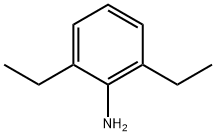
2,6-диэтиланилин
- английское имя2,6-Diethylaniline
- CAS №579-66-8
- CBNumberCB6259518
- ФормулаC10H15N
- мольный вес149.23
- EINECS209-445-7
- номер MDLMFCD00007753
- файл Mol579-66-8.mol
| Температура плавления | 3-4 °C |
| Температура кипения | 243 °C (lit.) |
| плотность | 0.906 g/mL at 25 °C (lit.) |
| давление пара | 0.02 mm Hg ( 20 °C) |
| показатель преломления | n |
| Fp | 254 °F |
| температура хранения | Keep in dark place,Inert atmosphere,Room temperature |
| растворимость | Chloroform (Slightly), Methanol (Slightly) |
| пка | 4.13±0.10(Predicted) |
| форма | Liquid |
| цвет | Clear yellow to reddish-brown |
| Растворимость в воде | 0.67g/L(26.7 ºC) |
| Чувствительный | Air Sensitive |
| БРН | 1423626 |
| Стабильность | Air Sensitive |
| Справочник по базе данных CAS | 579-66-8(CAS DataBase Reference) |
| Рейтинг продуктов питания EWG | 1 |
| FDA UNII | VT2234594H |
| Справочник по химии NIST | Benzenamine, 2,6-diethyl-(579-66-8) |
| Система регистрации веществ EPA | 2,6-Diethylaniline (579-66-8) |
| UNSPSC Code | 12352100 |
| NACRES | NA.22 |
| Коды опасности | Xn | |||||||||
| Заявления о рисках | 22 | |||||||||
| Заявления о безопасности | 23-24 | |||||||||
| РИДАДР | 2810 | |||||||||
| WGK Германия | 2 | |||||||||
| RTECS | BX3500000 | |||||||||
| F | 8-9-23 | |||||||||
| Класс опасности | 6.1(b) | |||||||||
| Группа упаковки | III | |||||||||
| кода HS | 29214200 | |||||||||
| Банк данных об опасных веществах | 579-66-8(Hazardous Substances Data) | |||||||||
| NFPA 704: |
|
рисовальное письмо(GHS)
-
рисовальное письмо(GHS)


-
сигнальный язык
предупреждение
-
вредная бумага
H315:При попадании на кожу вызывает раздражение.
H319:При попадании в глаза вызывает выраженное раздражение.
H302:Вредно при проглатывании.
H341:Предполагается, что данное вещество вызывает генетические дефекты.
-
оператор предупредительных мер
P201:Беречь от тепла, горячих поверхностей, искр, открытого огня и других источников воспламенения. Не курить.
P202:Перед использованием ознакомиться с инструкциями по технике безопасности.
P264:После работы тщательно вымыть кожу.
P270:При использовании продукции не курить, не пить, не принимать пищу.
P280:Использовать перчатки/ средства защиты глаз/ лица.
P301+P312+P330:ПРИ ПРОГЛАТЫВАНИИ: Обратиться за медицинской помощью при плохом самочувствии. Прополоскать рот.
P308+P313:ПРИ подозрении на возможность воздействия обратиться за медицинской помощью.
P405:Хранить в недоступном для посторонних месте.
P501:Удалить содержимое/ контейнер на утвержденных станциях утилизации отходов.
2,6-диэтиланилин химические свойства, назначение, производство
Химические свойства
Clear liquidМетоды производства
2,6-Diethylaniline is obtained in high yield when aniline is heated with ethylene at 200-300°C under high pressure in the presence of aluminum anilide (Northcott 1978).Общее описание
The 2,6-diethylaniline complexes with iodine, as a sigma-acceptor, were studied spectrophotometrically in chloroform, dichloromethane and carbontetrachloride solutions. It is an intermediate for the production of alachlor, butachlor, metolachlor-herbicides, tiafentiurone-insecticide, carbodiimide and RIM-PUR.Промышленное использование
2,6-Diethylaniline is used in the synthesis of herbicides such as Nevirex G and butachlor (Vertesi and Miklos 1982; Lee et al 1982).Метаболический путь
Incubation of 2,6-diethylaniline (DEA) with NADPH- fortified rat liver microsomal enzymes produces 4- amino-3,5-diethylphenol (ADEP) as the major oxidation product. ADEP is shown to undergo further oxidation to 3,5-diethylbenzoquinone-4-imine (DEBQI), which is isolated as a minor metabolite during DEA oxidation.Метаболизм
Incubation of 2,6-diethylaniline with NADPH-fortified microsomes produced 4-amino-3,5-diethylphenol (ADEP) as the major oxidation product (Feng and Wratten 1987). ADEP underwent further oxidation to 3,5-diethyl-benzoquinone-4-imine which is isolated as a minor metabolite during 2,6-diethylaniline metabolism. 2,6-Diethylaniline is produced under aerobic soil conditions as a minor metabolite of the herbicide butachlor (Lee et al 1982). 2,6-Diethylaniline is degraded by the soil microorganism Chaetomium globosum to 2,6-diethylacetanilide and 2,6-diethyl-p-benzoquinone (Lee and Ryu 1982). 2,6-Diethylaniline was also very persistent towards biodegradation in pond water with and without sewage sludge inoculation (Lyons et al 1985).2,6-диэтиланилин запасные части и сырье
сырьё
1of2
запасной предмет
1of2
2,6-диэтиланилин поставщик
| поставщик | телефон | страна | номенклатура продукции | благоприятные условия |
|---|---|---|---|---|
| +86 13288715578 +8613288715578 |
China | 12825 | 58 | |
| +8617531153977 | China | 5855 | 58 | |
| +86-13131129325 | China | 5887 | 58 | |
| +86-(0)57185586718 +86-13336195806 |
China | 29792 | 60 | |
| +86-0371-55170693 +86-19937530512 |
China | 21632 | 55 | |
| 008657128800458; +8615858145714 |
China | 7743 | 55 | |
| +86-0371-86658258 +8613203830695 |
China | 29871 | 58 | |
| 13867897135 | CHINA | 923 | 58 | |
| +86 519 86305871 | CHINA | 4241 | 58 | |
| 18871490254 | CHINA | 28172 | 58 |